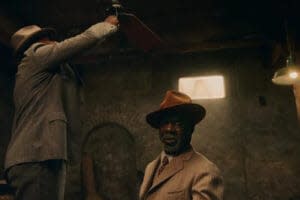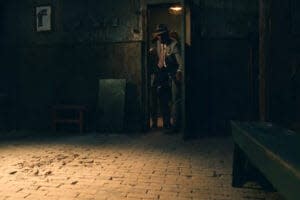How ‘Ma Rainey’s Black Bottom’ Production Designer Used a Steel Mill to Re-Create 1920s Chicago
- Oops!Something went wrong.Please try again later.
- Oops!Something went wrong.Please try again later.
- Oops!Something went wrong.Please try again later.
- Oops!Something went wrong.Please try again later.
- Oops!Something went wrong.Please try again later.
- Oops!Something went wrong.Please try again later.
Production designer Mark Ricker’s first job in the industry was an internship in the art department for “The Handmaid’s Tale.” Not the popular Hulu TV show, but the 1990 movie version of Margaret Atwood’s book. Three decades later, after credits that include “The Help,” “Bombshell” and “Julie & Julia,” Ricker has landed his first Oscar nomination, for creating the 1920s recording studio and ruined rehearsal rooms of “Ma Rainey’s Black Bottom.”
“It’s thrilling, I’ve gotta say,” Ricker told TheWrap. “People who had mentored me when I was an intern were calling to say congratulations. I heard from old colleagues in Italy and Australia and Mexico and Vancouver. It was a very happy moment for me and my team.” (He is nominated along with set decorators Karen O’Hara and Diana Sroughton.)
His competition includes movies set in 1880s Texas (“News of the World”), 1930s Los Angeles (“Mank”), contemporary London (“The Father”) and a world turned backward in time (“Tenet”).
Also Read: 'Ma Rainey's Black Bottom' Hair and Makeup: How Viola Davis Was Inspired by Bette Davis's Classic 'Baby Jane'
“Oh, it’s a great category,” he said. “And what’s interesting is that our footprint on ‘Ma Rainey’ is a bit smaller, because it’s mainly just two rooms. But it still felt like a whole landscape to get right and to honor the truth of what these places were and what August Wilson wrote about them. The nominations stuff can be a roll of the dice, but I feel good that the Academy recognized what we did.”
And for sure, though there are about 10 unique locations in the film, Ricker was acutely aware of the importance of the subterranean, 18-by-22-foot rehearsal room. That is where roughly half of the action takes place, including almost all of the late Chadwick Boseman’s Oscar-nominated performance.
“This one room had to carry so much of the film,” Ricker said. “I spent a lot of time in that room by myself. It felt real and it felt important. So I wanted it to be rich with history and texture and details. I hadn’t seen ‘Ma Rainey’ on stage and I made a decision not to read the play. But in our script (by Ruben Santiago-Hudson) the rehearsal space is described as a windowless basement storage room.”
The “windowless” part of that caused alarm for Ricker and cinematographer Tobias Schliessler, both apprehensive about how the room would appear onscreen without any shafts of natural light. Director George C. Wolfe was adamant.
“George wanted the room to feel like a tomb,” Ricker said. “He wanted it to evoke the hull of a slave ship. So there were conversations between Tobias and George, but while we were location scouting we saw a similar basement that did have a window high up. And I think George saw the potential of telling the story emotionally thought that window. Like the hull of a slave ship, where there might be a beam of light that you can’t reach.”

The window Ricker designed was deliberately small and dirty. “And we put a grill on it as well. Over the course of the story, we were able to use the light moving through the window for certain moments in the story. We see people’s legs walking past it or a car driving by and blocking it.”
The world outside that smudged glass, however, was closed steel mill in Pittsburgh, Pennsylvania, which has recently been converted into a studio. The film’s exterior shots were dressed and designed to simulate the hot Chicago summer in the roaring 20s.
Even the alleyway that the characters walk through was built in a parking lot next to a historically accurate building in Pittsburgh. Brick by brick, the wall in the alleyway was then moved to the sound stage in the steel mill, for shots where the alley is visible from inside.
“That was a way to keep the scenery consistent,” Ricker said. “And also a way to save a dime on the budget.”
The 19th century steel mill, known now as the 31st Street Studios, also revealed hidden treasures to Ricker and his team. “There was an ancient crane in the mill with these huge footings,” he said. “And at the very last minute I thought to rotate the set so that all those steel columns were right outside the windows of our sets. They looked just like the footings of an elevated train in Chicago.”
See the original steel mill stage here, via 31st Street Studio’s Twitter account.
Need a place for a #photography shoot or a short term rental? We’d love to have you down at our #studios! We still have a few unoccupied stages. So why not bring your next project here? pic.twitter.com/pmhZzYu0Zf
– 31st Street Studios (@31stStStudios) February 12, 2021
The floor of the steel mill was another source of free scenery. “It was mostly concrete slab, but there was some original brick that was exposed on the floor. There was just enough of it in the corner of the stage for us to build the rehearsal room in that spot. That amazing brick is all crumbled and broken, but it gave such a weight to the drama, particularly given how the movie ends with characters on the floor.”

Ricker remembered being in that room when Viola Davis, who dominates the film but only appears very briefly in the rehearsal-room set, first set foot on the sound stage. “I mentioned to Viola that George wanted this room to evoke the hull of a slave ship, and I just remember her just staring at the ground and absorbing that detail.”
When asked about Boseman in our interview, Ricker’s whole demeanor changed, became quieter and less buoyant. He had also worked with Boseman on the 2014 James Brown biopic “Get On Up.”
“I remember when we did ‘Get On Up’ and Chad came up to me and was like, ‘I see the job you’re doing, I’m watching.’ He was always so keyed into everything going on. I was a bit different on ‘Ma Rainey.’ He was deep in the character. And I understood that when I saw very early cut of the film and knew it was the best thing he’d ever done.”
A year after finishing production on the film, Ricker recalled, “A friend of mine texted me and said, ‘You worked with Chad, right?’ And I was like, ‘Yeah, twice, Why?'” He paused. “It was incomprehensible, the news. Such a gut punch. He hasn’t won the Oscar yet, but I think he will. There’s that twinkle in his eye in ‘Ma Rainey,’ when he’s talking about having his whole life ahead of him. It goes without saying that his loss is still unthinkable.”
On a less somber note, Ricker’s upcoming projects include the Netflix series “Halston,” about the American fashion designer. And during 2020, when the film and TV industries paused production due to the pandemic, he had an amusing experience in upstate New York, visiting Bette Midler’s home in upstate New York for HBO’s Corona-era comedy film “Coastal Elites.”
“We were literally the first people outside of (Midler’s) family who had broached the gate of her house,” he said. “Her husband has a painter’s studio, which we turned into a police interrogation room for the film. And it was really great to meet Bette Milder.” He added with a laugh, “Even if she stood 25 feet away with about six masks on.”
“Ma Rainey’s Black Bottom” is available to stream on Netflix. The Oscars will air on April 25.
Read original story How ‘Ma Rainey’s Black Bottom’ Production Designer Used a Steel Mill to Re-Create 1920s Chicago At TheWrap
